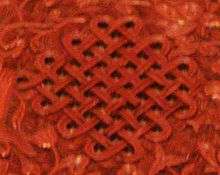Endless knot
The endless knot or eternal knot (Sanskrit: śrīvatsa; simplified Chinese: 盘长结; traditional Chinese: 盤長結; pinyin: pánzhǎng jié; Tibetan དཔལ་བེའུ། dpal be'u; Mongolian Улзии) is a symbolic knot and one of the Eight Auspicious Symbols. It is an important symbol in both Jainism and Buddhism. It is an important cultural marker in places significantly influenced by Tibetan Buddhism such as Tibet, Mongolia, Tuva, Kalmykia, and Buryatia. It is also found in Celtic and Chinese symbolism.


In Jainism it is one of the eight auspicious items, an asthamangala, however found only in the Svetambara sect. It is often found marking the chests of the 24 Saints, the tirthankaras. It is more commonly referred to as the Shrivatsa.
History
The endless knot symbol appears on clay tablets from the Indus Valley Civilization (2500 BC),[1] and the same symbol also appears on an historic era inscription.[2]
Interpretations
Various interpretations of the symbol are:
- The eternal continuum of mind.
- The endless knot iconography symbolised Samsara i.e., the endless cycle of suffering or birth, death and rebirth within Tibetan Buddhism.
- The inter-twining of wisdom and compassion.
- Interplay and interaction of the opposing forces in the dualistic world of manifestation, leading to their union, and ultimately to harmony in the universe.
- The mutual dependence of religious doctrine and secular affairs.
- The union of wisdom and method.
- The inseparability of emptiness (shunyata) and dependent origination, the underlying reality of existence.
- Symbolic of knot symbolism in linking ancestors and omnipresence (refer etymology of Tantra, Yoga and religion) (see Namkha.)
- Since the knot has no beginning or end it also symbolizes the wisdom of the Buddha.
In other cultures
See 7₄ knot for decorations or symbols in other cultures which are topologically equivalent to the interlaced form of the simplest version of the Buddhist endless knot.[3]
See also
- Ashtamangala (also known as Eight Auspicious Symbols)
- Celtic knot
- Chinese knotting
- Eternal return
- Gordian knot
- Indra's net
- Islamic interlace patterns
- Khachkars – Armenian knotwork
- Knot garden
- Knot theory
- Mandala
- Möbius strip
- Namkha
- Oseberg style
- Ouroboros
- Solomon's knot
- Tantra
- Three hares
- Trefoil knot
- Triquetra
- Turk's head knot
- Valknut
- Yin and yang
Notes and references
- Beer, Robert (2003). The Handbook of Tibetan Buddhist Symbols (PDF). Serindia Publications. p. 11. ISBN 1-59030-100-5. Archived (PDF) from the original on 3 April 2018.
- Danino, Michel (2010). Lost River: On The Trail of the Sarasvati. Penguin Books. ISBN 978-0143068648.
- "7_4", The Knot Atlas.
External links
| Wikimedia Commons has media related to Endless knots. |
- "The Endless Knot (Skt. shrivatsa; Tib. dpal be'u)", TwilightBridge.com.
- "Endless Knot", ReligionFacts.com.